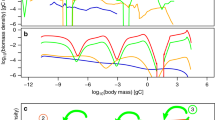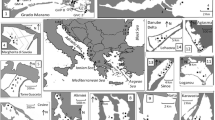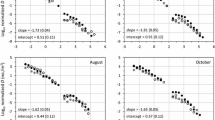Abstract
Much has been published about different aspects of body-size distribution resting on the assumptions of metabolic scaling, although a number of studies in aquatic ecosystems have questioned its generality. This study considers the effects of individual body-mass and biomass variability on scaling properties of multi-species communities (protists, meio- and macroinvertebrates), and their intrinsic variations in assemblage structure. We examine how size traits within communities are distributed on local and regional scales and assess the potential sources of variation affecting whole ecosystems. Our results, built upon seven river catchment communities including 1204 species, revealed micro-meiofauna-dominated biomass distributions driven by stochastic hydrophysical processes that induce a fractal fluctuation scaling, irrespective of trophic levels, shaping local and regional scaling relations. Fractal-scaling differences are largely generated by the frequency of high flow events that influence the biomass assemblage configurations, which are significantly better represented by the Power Fraction model compared to single statistical random models. We conclude that environmental random variability contributes to the decoupling of total biomass and body mass per site from assemblage size, resulting in scale-invariant body-size traits among assemblages and systems. Generally, these findings emphasize that ignoring small-sized species and, thus, the wide range of body sizes makes accurate ecological model predictions, impossible.



Similar content being viewed by others
References
Arakaki, S. & M. Tokeshi, 2019. Biomass compensation: behind the diversity gradients of tidepool fishes. Population Ecology 2019: 1–10.
Armanini, A., 2018. Principles of River Hydraulics. Springer, New York: 217.
Calder III, W. A., 1996. Size, Function, and Life History. Dover Publications Inc, Mineola: 431.
Cash, J. & J. Hopkinson, 1905–1921. The British Freshwater Rhizopoda and Heliozoa, Vol I–V. The Ray Society. London.
Cohen, J. E. & M. Xu, 2015. Random sampling of skewed distributions implies Taylor’s power law of fluctuation scaling. Proceedings of the National Academy of Sciences USA 112: 7749–7754.
Cribari-Neto, F. & S. G. Zarkos, 1999. Bootstrap methods for heteroskedastic regression models: evidence on estimation and testing. Economic Reviews 18: 211–228.
Donner, J., 1965. Ordnung Bdelloidea (Rotatoria, Rädertiere). Akademie Verlag, Berlin: 297.
Duplisea, D. E., 2000. Benthic organism biomass size-spectra in the Baltic Sea in relation to the sediment environment. Limnology and Oceanography 45: 558–568.
Edwards, A. M., J. P. W. Robinson, M. J. Plank, J. K. Baum & J. L. Blanchard, 2017. Testing and recommending methods for fitting size spectra to data. Methods in Ecology and Evolution 8: 57–67.
Eisler, Z., I. Bartos & J. Kertész, 2008. Fluctuation scaling in complex systems: Taylor’s law and beyond. Advances in Physics 57: 89–142.
Enquist, B. J. & K. J. Niklas, 2001. Invariant scaling relations across tree-dominated communities. Nature 410: 655–660.
Fronczak, A. & P. Fronczak, 2010. Origins of Taylor’s power law for fluctuation scaling in complex systems. Physical Review E 81: 066112.
Gaedke, U., 1993. Ecosystem analysis based on biomass size distributions: a case study of a plankton community in a large lake. Limnology & Oceanography 38: 112–127.
Gaston, K. J., P. A. V. Borges, F. He & C. Gaspar, 2006. Abundance, spatial variance and occupancy: arthropod species distribution in the Azores. Journal of Animal Ecology 75: 646–656.
Gibbins, C., D. Vericat & R. J. Batalla, 2007. When is stream invertebrate drift catastrophic? The role of hydraulic and sediment transport in initiating drift during flood events. Freshwater Biology 52: 2369–2384.
Gisiger, T., 2001. Scale invariance in biology: coincidence or footprint of a universal mechanism? Biological Review Cambridge Philosophical Society 76: 161–209.
Gneiting, T. & M. Schlather, 2004. Stochastic models that separate fractal dimension and the Hurst effect. Society for Industrial and Applied Mathematics Review 46: 269–282.
Haggerty, S. M., D. P. Batzer & C. R. Jackson, 2002. Macroinvertebrate assemblages in perennial headwater streams of the Coastal Mountain range of Washington, U.S.A. Hydrobiologia 479: 143–154.
Holomuzki, J. R. & B. J. F. Biggs, 2003. Sediment texture mediates high-flow effects on lotic macroinvertebrates. Journal of the North American Benthological Society 22: 542–553.
Hopper, G. W., K. B. Gido, C. C. Vaughn, T. B. Parr, T. G. Popejoy, C. L. Atkinson & K. K. Gates, 2018. Biomass distribution of fishes and mussels mediates spatial and temporal heterogeneity in nutrient cycling in streams. Oecologia 188: 1133–1144.
Isaac, N. J. B., D. Storch & C. Carbone, 2013. The paradox of energy equivalence. Global Ecology and Biogeography 22: 1–5.
Kalyuzhny, M., Y. Schreiber, R. Chocron, C. H. Flather, R. Kadmon, D. A. Kessler & N. M. Shnerb, 2014. Temporal fluctuation scaling in populations and communities. Ecology 95: 1701–1709.
Kendal, W. S. & B. Jørgensen, 2011. Tweedie convergence: a mathematical basis for Taylor’s power law, 1/f noise, and multifractality. Physical review E 84: 066120.
Kilpatrick, A. M. & A. R. Ives, 2003. Species interactions can explain Taylor’s power law for ecological time series. Nature 422: 65–68.
Lynn, D. H., 2008. The Ciliated Protozoa Characterization, Classification, and Guide to the Literature, 3rd ed. Springer, New York.
Marquet, P. A., R. A. Quiñones, S. Abades, F. Labra, M. Tognelli, M. Arim & M. Rivadeneira, 2005. Scaling and power-laws in ecological systems. Journal of Experimental Biology 208: 1749–1769.
Ogden, G. G. & R. H. Hedley, 1980. An atlas of freshwater testate amoebae. Soil Science 130: 176.
Page, F. C. & F. J. Siemensma, 1991. Nackte Rhizopoda und Heliozoa. Gustav Fischer, Stuttgart: 297.
Park, S.-J., R. A. J. Taylor & P. S. Grewald, 2013. Spatial organization of soil nematode communities in urban landscapes: Taylor’s Power Law reveals life strategy characteristics. Applied Soil Ecology 64: 214–222.
Peters, R. H., 1983. The ecological implications of body size. Cambridge University Press, Cambridge: 329.
Platt, T. & K. Denman, 1977. Organisation in the pelagic ecosystem. Helgoländer Meeresuntersuchungen 30: 575–581.
Quintana, X. D., F. A. Comin & R. Moreno-Amich, 2002. Biomass-size spectra in aquatic communities in shallow fluctuating Mediterranean salt marshes (Emporda wetlands, NE Spain). Journal of Plankton Research 24: 1149–1161.
R Development Core Team, 2008. R: A Language and Environment for Statistical Computing. R Foundation for Statistical Computing, Vienna.
Robert, A., 2003. River Processes. An Introduction to fluvial dynamics. ARNOLD, London: 214.
Schmid, P. E., 1992. Habitat preferences as patch selection of larval and emerging chironomids (Diptera) in a gravel brook. Netherlands Journal of Aquatic Ecology 26: 419–429.
Schmid, P. E., 1993. A key to the larval Chironomidae and their instars from Austrian Danube region streams and rivers—with particular reference to a numerical taxonomic approach. Part I. Diamesinae, Prodiamesinae and Orthocladiinae. Wasser und Abwasser, Supplement 3: 1–514.
Schmid, P. E., 2000. The fractal properties of habitat and patch structure in benthic ecosystems. Advances Ecological Research 30: 339–401.
Schmid, P.E. & J. M. Schmid-Araya, in press. Application of multifractal analyses to habitat complexity research in stream systems: a cross-scale approach. In Tokeshi, M. (ed.), Habitat Complexity in Aquatic Systems: Ecological Perspectives.
Schmid, P. E. & J. M. Schmid-Araya, 1997. Predation on meiobenthic assemblages: resource use of a tanypod guild (Chironomidae, Diptera) in a gravel stream. Freshwater Biology 38: 67–91.
Schmid, P. E. & J. M. Schmid-Araya, 2007. Body size and scale invariance: multifractals in invertebrate communities. In Hildrew, A. G., D. G. Raffaelli & R. Edmonds-Brown (eds), Body Size: The Structure and Function of Aquatic Ecosystems. Cambridge University Press, Cambridge: 140–166.
Schmid, P. E. & J. M. Schmid-Araya, 2010. Scale-dependent relations between bacteria, organic matter and invertebrates in a headwater-stream. Fundamental and Applied Limnology, Archiv für Hydrobiologie 176: 275–365.
Schmid, P. E., M. Tokeshi & J. M. Schmid-Araya, 2000. Relationship between population density and body size in stream communities. Science 389: 1557–1560.
Schmid, P. E., M. Tokeshi & J. M. Schmid-Araya, 2002. Scaling in stream communities. Proceedings of the Royal Society London B 269: 2587–2594.
Schmid-Araya, J. M., 2000. Invertebrate recolonization patterns in the hyporheic zone of a gravel stream. Limnology & Oceanography 45: 1000–1005.
Schmid-Araya, J. M. & P. E. Schmid, in press. Habitat complexity and meiofauna: a review and new insights on food-search dynamics of organisms across habitat patches of varying complexity. In Tokeshi, M. (ed.), Habitat Complexity in Aquatic Systems: Ecological Perspectives.
Schmid-Araya, J. M., P. E. Schmid, A. Robertson, J. Winterbottom, C. Gjerlov & A. G. Hildrew, 2002. Connectance in stream food webs. Journal of Animal Ecology 71: 1056–1062.
Schmid-Araya, J. M., P. E. Schmid, S. P. Tod & G. F. Esteban, 2016. Trophic positioning of meiofauna revealed by stable isotopes and food web analyses. Ecology 97: 3099–3109.
Schönborn, W., 1977. Production studies on protozoa. Oecologia 27: 171–184.
Smith, B. & J. B. Wilson, 1996. A consumer’s guide to evenness indices. Oikos 76: 70–82.
Statzner, B., J. A. Gore & V. H. Resh, 1988. Hydraulic stream ecology: observed patterns and potential applications. Journal of the North American Benthological Society 7: 307–360.
Stead, T. K., J. M. Schmid-Araya & A. G. Hildrew, 2004. The contribution of subsurface invertebrates to benthic density and biomass in a gravel stream. Archiv für Hydrobiologie 160: 171–191.
Stead, T. K., J. M. Schmid-Araya, P. E. Schmid & A. G. Hildrew, 2005. The distribution of body size in a stream community: one system, many patterns. Journal of Animal Ecology 74: 475–487.
Taylor, L. R., 1961. Aggregation, variance and the mean. Nature 189: 732–735.
Taylor, L. R., R. A. J. Taylor, I. P. Woiwood & J. N. Perry, 1983. Behavioural dynamics. Nature 303: 801–804.
Tokeshi, M., 1995. On the mathematical basis of the variance-mean power relationship. Research in Population Ecology 37: 43–48.
Tokeshi, M., 1996. Power fraction: a new explanation for species abundance patterns in species-rich assemblages. Oikos 75: 543–550.
Tokeshi, M., 1999. Species Coexistence. Ecological and revolutionary perspectives. Blackwell Science Ltd., Oxford: 454.
Violle, C., B. J. Enquist, B. J. McGill, L. Jiang, C. H. Albert, C. Hulshof, V. Jung & J. Messier, 2012. The return of the variance: intraspecific variability in community ecology. Trends in Ecology and Evolution 27: 244–252.
Voković, M. & A. Soro, 1992. Determination of hydraulic conductivity of porous media from grain-size composition. Water Resource publications, Littleton: 83.
Warwick, R. M., S. L. Dashfield & P. J. Somerfield, 2006. The integral structure of a benthic infaunal assemblage. Journal of Experimental Marine Biology and Ecology 330: 12–18.
Witek, Z. & A. Krajewska-Soltys, 1989. Some examples of the epipelagic plankton size structure in latitude oceans. Journal of Plankton Research 11: 1143–1155.
Acknowledgments
This work has been supported by grants from NERC (NER/A/S/2001/00566), the Royal Society, and in parts from the Austrian Science Fund FWF: P15597-B03. We thank Dr C. Fesl, Mr R. Niederreiter and E. Lanzenberger for their assistance and suggestions during field and lab work. We also appreciate the comments and helpful suggestions of two anonymous referees on an earlier draft of the MS.
Author information
Authors and Affiliations
Corresponding author
Additional information
Publisher's Note
Springer Nature remains neutral with regard to jurisdictional claims in published maps and institutional affiliations.
Guest editors: Nabil Majdi, Jenny M. Schmid-Araya & Walter Traunspurger / Patterns and Processes of Meiofauna in Freshwater Ecosystems
Electronic supplementary material
Below is the link to the electronic supplementary material.
Rights and permissions
About this article
Cite this article
Schmid, P.E., Schmid-Araya, J.M. & Tokeshi, M. The scaling of biomass variance across trophic levels in stream species communities: a macroecological approach. Hydrobiologia 847, 2705–2723 (2020). https://doi.org/10.1007/s10750-020-04239-5
Received:
Revised:
Accepted:
Published:
Issue Date:
DOI: https://doi.org/10.1007/s10750-020-04239-5




